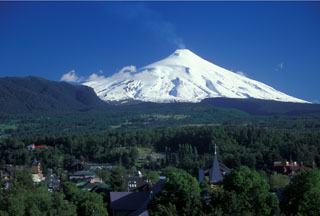Report on Villarrica (Chile) — 5 October-11 October 2022
Smithsonian Institution / US Geological Survey
Weekly Volcanic Activity Report, 5 October-11 October 2022
Managing Editor: Sally Sennert.
Please cite this report as:
Global Volcanism Program, 2022. Report on Villarrica (Chile) (Sennert, S, ed.). Weekly Volcanic Activity Report, 5 October-11 October 2022. Smithsonian Institution and US Geological Survey.
Villarrica
Chile
39.42°S, 71.93°W; summit elev. 2847 m
All times are local (unless otherwise noted)
POVI reported increased activity at Villarrica on 10 October. A thermal anomaly was identified in satellite images and was the most intense anomaly recorded since January 2021. Incandescence above the crater rim was visible in a webcam image. The Alert Level remained at Green, the lowest level on a four-color scale.
Geological Summary. The glacier-covered Villarrica stratovolcano, in the northern Lakes District of central Chile, is ~15 km south of the city of Pucon. A 2-km-wide caldera that formed about 3,500 years ago is located at the base of the presently active, dominantly basaltic to basaltic andesite cone at the NW margin of a 6-km-wide Pleistocene caldera. More than 30 scoria cones and fissure vents are present on the flanks. Plinian eruptions and pyroclastic flows that have extended up to 20 km from the volcano were produced during the Holocene. Lava flows up to 18 km long have issued from summit and flank vents. Eruptions documented since 1558 CE have consisted largely of mild-to-moderate explosive activity with occasional lava effusion. Glaciers cover 40 km2 of the volcano, and lahars have damaged towns on its flanks.
Sources: Proyecto Observación Villarrica Internet (POVI), Servicio Nacional de Geología y Minería (SERNAGEOMIN)

